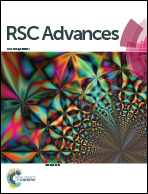Fluorinated glycidyl azide polymers as potential energetic binders†
Abstract
To improve the mechanical properties of glycidyl azide polymer (GAP)-based polyurethane network binders, a novel fluorinated glycidyl azide polymer, (2,2,2-trifluoro-ethoxymethyl epoxy-r-glycidyl azide) copolymer (poly(TFEE-r-GA)) was synthesized through an initial cationic copolymerization of epichlorohydrin and 2,2,2-trifluoro-ethoxymethyl epoxy, followed by azidation. The structure of poly(TFEE-r-GA) was characterized by FTIR, 1H NMR, 13C NMR and GPC. DSC and TGA were used to investigate the thermal behavior of poly(TFEE-r-GA), the glass transition temperature and decomposition temperature of poly(TFEE-r-GA) were found to be −49.5 and 250 °C, respectively. The copolyurethane networks were further synthesized by cross-linking poly(TFEE-r-GA) using trimethylolpropane as a chain extender agent, using isophorone diisocyanate as a cross-linking agent. In comparison with GAP, the poly(TFEE-r-GA) based copolyurethane networks exhibited relatively better mechanical properties, which had a tensile strength of 5.52 MPa, and an elongation at break of 162.8%. All the results indicated that the fluorine-containing GAP might serve as a potential energetic binder for future propellant formulations.



 Please wait while we load your content...
Please wait while we load your content...